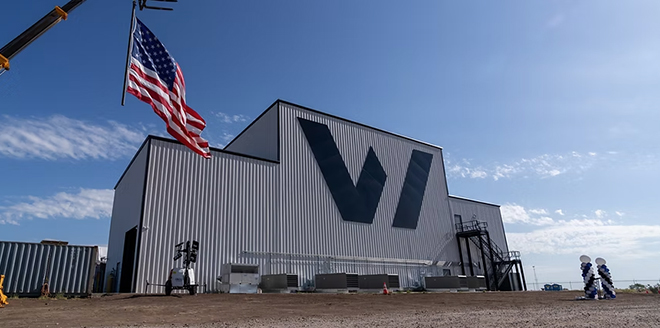Featured Topics
Featured Products
Events
S&P Global Offerings
Featured Topics
Featured Products
Events
S&P Global Offerings
Featured Topics
Featured Products
Events
S&P Global Offerings
Featured Topics
Featured Products
Events
Financial and Market intelligence
Fundamental & Alternative Datasets
Government & Defense
Banking & Capital Markets
Economy & Finance
Energy Transition & Sustainability
Technology & Innovation
Podcasts & Newsletters
Financial and Market intelligence
Fundamental & Alternative Datasets
Government & Defense
Banking & Capital Markets
Economy & Finance
Energy Transition & Sustainability
Technology & Innovation
Podcasts & Newsletters
12 May, 2025

| Westwin Elements is building America's first nickel refinery, in Oklahoma, to reduce the nation's reliance on foreign supply chains. |
➤ The nickel market, pressured by excess production in Indonesia, may have found its floor price.
➤ Westwin Elements Inc.'s planned refining plant in Lawton, Oklahoma, can withstand low nickel prices and an oversupplied market.
➤ Tariffs are a better way to support US producers than supply chain restrictions.
The US produces no primary nickel, but Westwin Elements aims to change that with its nickel refinery in Oklahoma. The company, which plans to scale its pilot plant up to 64,000 metric tons of annual capacity, received a letter of interest from the Export-Import Bank of the United States in January for up to $188 million in debt financing.
Indonesia has flooded the nickel market, with the help of Chinese technology and investments, decreasing prices and pressuring producers in other parts of the world. The London Metal Exchange cash price for nickel hit $15,620.98/t on May 9, up 3.4% from the start of the year but well off the highs of 2022 and 2023.
Westwin CEO KaLeigh Long believes the company's refinery can compete with Indonesian operations on some cost metrics, especially if the US accelerates permitting for new mines. Westwin expects operating in the US will improve its environmental, social and governance metrics, while avoiding certain humanitarian problems such as deforestation.
S&P Global Commodity Insights recently discussed nickel, tariffs and geopolitics with Long. The following conversation has been edited for clarity and space.
 KaLeigh Long, founder and CEO of Westwin Elements. |
S&P Global Commodity Insights: You have a unique business background. What interested you in the critical mineral space?
KaLeigh Long:
I did some volunteer work in the Democratic Republic of Congo, Lebanon, and a Syrian refugee camp. That international exposure led me to critical minerals. And I've long been very concerned about some of these gross atrocities in resource-rich countries. But the businesswoman in me realized if any of that was going to ever be cured, it likely wasn't going to happen from the US government or some of these other governments. American business had to show up and create influence.
How did you decide on the nickel refining?
What inspired me to get into critical minerals and to start as a refiner, a processor, is that in the cattle and beef industry, the rancher seems to be the one who takes all the risk, and a substantial amount of risk and seems to have the least control in the overall market. Whereas the packer seemed to centralize the control and the largest margins.
When I saw critical minerals, I was like, oh, I'm sick of being the rancher. I want to be the packer. I used that logic and realized — and I think rightly so — that being the processor and the refiner is the least risk in the supply chain. It certainly seems to give a huge controlling factor in the market.
Indonesia controls a higher percentage of nickel production than OPEC did for oil at its peak in the 1970s.
They have flooded the markets, yes, and, as you know, it is Indonesian in origin, but it's not Indonesian in ownership. So, China owns what is clearly defined as about 75% of the total Indonesian nickel market share.
So, how do we survive? You know, many in the industry, much more experienced than myself, seem to affirm that nickel has hit its floor, and I think what we're feeling from the banks is that $16,500
We can survive largely because we are a transformation business. If we were a mining operation here in the US, or in Australia, Kosovo, North Macedonia or Guatemala, we would struggle. But again, we buy our feedstock at a market price. We sell our product on a market-based formula. ... We are a bankable project.
It's also really important to know that Chinese producers are not making money at these low prices. I was in China in March. I toured multiple cities and sites of these majors in China. And many of these majors have reported severe losses.
I think there is a limitation to how far the Chinese government can subsidize these losing operations. And the sentiment that I got there is that these Chinese producers, some of them state-owned, are fatigued, and they're ready for the price to increase. When I'm hearing that from a pure cost basis, to me, we have a floor.
The planned NorthMet copper-nickel mine in Minnesota was added to the US' FAST-41 permitting program. Once operational, how could that project affect your operations?
We are huge fans of them. You know, we are competing against Chinese operating costs, which, incredibly, we are quite competitive with. We actually think we're only a few hundred dollars more expensive on a pure cost basis to China. But where we are not competitive is China's supply chains. They are localized either in China or neighboring Asian countries.
Their savings on logistics is extraordinary. And so, logistics is one of the most expensive components of our business.
We are rooting for success in Minnesota because it would likely allow us to compete with China on logistics costs, not just operating cost. It would inspire reliability and security on supply chains and then obviously mitigate many of the ESG concerns we have with some of the producers in Indonesia, especially.
To stay competitive, some nickel producers suggested the concept of "green nickel" as opposed to "dirty nickel," which puts a premium on sustainable development. Would you be supportive of this idea?
I would, but I don't think it will happen anytime soon. I have been in multiple negotiations with customers who say they value ESG and say they want cleaner nickel, but I have yet to see that translate into a real premium. Sadly, I'm not optimistic.
I will say that what I've advocated for and I think also will translate to a cleaner nickel unit one day is to have an ex-China nickel price and a China nickel price. Because something that we feel more and more from customers is that they really don't want Chinese ownership in our supply chain. There's, I think, a little bit of assumed ESG compliance with that removal ... at least transparency and controls.
How are you seeing demand for nickel shaping out over the medium to long term?
We are somewhat pessimistic about the rate of electrification in the United States, but even if it does grow gradually and not at the rapid pace that had been estimated in the past, it still is a new use in demand for nickel. And then, beyond that, as our world just gets more technical and mechanical, it tends to be more of a requirement for Class 1 nickel, whether it's AI or robotics. There are just so many applications.
But I would say, absent modernization, and absent these growing uses from increased technologies, there is nothing novel but something very steady about the demand based on stainless steel ammunition, armored plating, jet engines, etc.
That brings us to the question of tariffs. Do you think higher tariffs on critical minerals would hurt or benefit a nascent nickel industry in the United States?
I think tariffs are not just beneficial, they are vital for our industry. As complicated as the tariff layout is, it is still far simpler in my opinion than a
China was bragging about divesting from these Free Trade Agreement countries and cloaking themselves into other jurisdictions. For me, it was a layer of bureaucracy that actually wasn't going to lead to the overall objective success. Tariffs are quite clearly understood and defined, and they're very easy to calculate. So, when we're trying to sell our product to a customer, you can simply factor in that import parity, and there's a premium, so we can do a discount to the import parity.
If you buy American, you're saving money. Tariffs and the 45X tax credit, we think, are the great equalizer in the US-China competition in the nickel space.